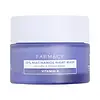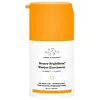What's inside
What's inside
 Key Ingredients
Key Ingredients

 Benefits
Benefits

 Concerns
Concerns

 Ingredients Side-by-side
Ingredients Side-by-side

Water
Skin ConditioningPropanediol
SolventNiacinamide
SmoothingC15-19 Alkane
SolventCaprylic/Capric Triglyceride
MaskingGlycerin
HumectantPanthenol
Skin Conditioning1,2-Hexanediol
Skin ConditioningCetearyl Olivate
Cetearyl Alcohol
EmollientSorbitan Olivate
EmulsifyingButyrospermum Parkii Butter
Skin ConditioningBetaine
HumectantVaccinium Corymbosum Seed Oil
AntioxidantTocopheryl Acetate
AntioxidantBeta-Glucan
Skin ConditioningBisabolol
MaskingAllantoin
Skin ConditioningMelia Azadirachta Flower Extract
Skin ConditioningGlycogen
HumectantCoccinia Indica Fruit Extract
Skin ConditioningLactobacillus Ferment
Skin ConditioningCorallina Officinalis Extract
Skin ConditioningSolanum Melongena Fruit Extract
Skin ConditioningAloe Barbadensis Flower Extract
EmollientSimmondsia Chinensis Seed Oil
EmollientZingiber Officinale Root Extract
MaskingCurcuma Longa Root Extract
MaskingOcimum Basilicum Flower/Leaf Extract
TonicOcimum Sanctum Leaf Extract
Skin ConditioningMaltodextrin
AbsorbentArginine
MaskingCarbomer
Emulsion StabilisingPentylene Glycol
Skin ConditioningSodium Phytate
Melia Azadirachta Leaf Extract
Skin ConditioningCaprylyl Glycol
EmollientWater, Propanediol, Niacinamide, C15-19 Alkane, Caprylic/Capric Triglyceride, Glycerin, Panthenol, 1,2-Hexanediol, Cetearyl Olivate, Cetearyl Alcohol, Sorbitan Olivate, Butyrospermum Parkii Butter, Betaine, Vaccinium Corymbosum Seed Oil, Tocopheryl Acetate, Beta-Glucan, Bisabolol, Allantoin, Melia Azadirachta Flower Extract, Glycogen, Coccinia Indica Fruit Extract, Lactobacillus Ferment, Corallina Officinalis Extract, Solanum Melongena Fruit Extract, Aloe Barbadensis Flower Extract, Simmondsia Chinensis Seed Oil, Zingiber Officinale Root Extract, Curcuma Longa Root Extract, Ocimum Basilicum Flower/Leaf Extract, Ocimum Sanctum Leaf Extract, Maltodextrin, Arginine, Carbomer, Pentylene Glycol, Sodium Phytate, Melia Azadirachta Leaf Extract, Caprylyl Glycol
Water
Skin ConditioningAzelaic Acid 10%
BufferingHydroxyethyl Acrylate/Sodium Acryloyldimethyl Taurate Copolymer
Emulsion StabilisingSalicylic Acid 1%
MaskingGlycerin
HumectantCucurbita Pepo Seed Oil
EmollientSalvia Hispanica Seed Oil
MoisturisingSclerocarya Birrea Seed Oil
HumectantPentylene Glycol
Skin ConditioningDiglucosyl Gallic Acid
Niacinamide
SmoothingPhloretin
AntioxidantAllantoin
Skin ConditioningFerulic Acid
AntimicrobialDipotassium Glycyrrhizate
HumectantTremella Fuciformis Sporocarp Extract
AntioxidantBehenic Acid
CleansingGlutathione
Linoleic Acid
CleansingTocotrienols
Skin ConditioningThioctic Acid
AntioxidantLinolenic Acid
CleansingErgothioneine
AntioxidantCholesterol
EmollientCeramide Ns
Skin ConditioningCeramide AP
Skin ConditioningCeramide EOP
Skin ConditioningCeramide Eos
Skin ConditioningCeramide NP
Skin ConditioningSodium Hyaluronate Crosspolymer
HumectantAmylopectin
Ellagic Acid
Skin ConditioningPseudozyma Epicola/Camellia Sinensis Seed Oil Ferment Extract Filtrate
HumectantCaprooyl Phytosphingosine
Skin ConditioningCaprooyl Sphingosine
Skin ConditioningSqualane
EmollientAscorbyl Palmitate
AntioxidantAcetyl Glucosamine
Skin ConditioningPunica Granatum Extract
AstringentDextrin
AbsorbentSebacic Acid
BufferingOryza Sativa Bran Oil
EmollientTocopherol
AntioxidantCeteareth-25
CleansingPhenoxyethanol
PreservativeSorbitan Isostearate
EmulsifyingPolydextrose
HumectantCetyl Alcohol
EmollientCaprylyl Glycol
EmollientChlorphenesin
AntimicrobialPolysorbate 60
EmulsifyingEthylhexylglycerin
Skin ConditioningWater, Azelaic Acid 10%, Hydroxyethyl Acrylate/Sodium Acryloyldimethyl Taurate Copolymer, Salicylic Acid 1%, Glycerin, Cucurbita Pepo Seed Oil, Salvia Hispanica Seed Oil, Sclerocarya Birrea Seed Oil, Pentylene Glycol, Diglucosyl Gallic Acid, Niacinamide, Phloretin, Allantoin, Ferulic Acid, Dipotassium Glycyrrhizate, Tremella Fuciformis Sporocarp Extract, Behenic Acid, Glutathione, Linoleic Acid, Tocotrienols, Thioctic Acid, Linolenic Acid, Ergothioneine, Cholesterol, Ceramide Ns, Ceramide AP, Ceramide EOP, Ceramide Eos, Ceramide NP, Sodium Hyaluronate Crosspolymer, Amylopectin, Ellagic Acid, Pseudozyma Epicola/Camellia Sinensis Seed Oil Ferment Extract Filtrate, Caprooyl Phytosphingosine, Caprooyl Sphingosine, Squalane, Ascorbyl Palmitate, Acetyl Glucosamine, Punica Granatum Extract, Dextrin, Sebacic Acid, Oryza Sativa Bran Oil, Tocopherol, Ceteareth-25, Phenoxyethanol, Sorbitan Isostearate, Polydextrose, Cetyl Alcohol, Caprylyl Glycol, Chlorphenesin, Polysorbate 60, Ethylhexylglycerin
 Reviews
Reviews

Alternatives
Ingredients Explained
These ingredients are found in both products.
Ingredients higher up in an ingredient list are typically present in a larger amount.
Allantoin is a soothing ingredient known for its protective and moisturizingg properties. Because of this, it is often added to products with strong active ingredients.
Studies show higher concentrations of this ingredient can promote wound healing.
Though it can be derived from the comfrey plant, allantoin is produced synthetically for cosmetic products to ensure purity.
Learn more about AllantoinCaprylyl Glycol is a humectant and emollient, meaning it attracts and preserves moisture.
It is a common ingredient in many products, especially those designed to hydrate skin. The primary benefits are retaining moisture, skin softening, and promoting a healthy skin barrier.
Though Caprylyl Glycol is an alcohol derived from fatty acids, it is not the kind that can dry out skin.
This ingredient is also used as a preservative to extend the life of products. It has slight antimicrobial properties.
Learn more about Caprylyl GlycolGlycerin is already naturally found in your skin. It helps moisturize and protect your skin.
A study from 2016 found glycerin to be more effective as a humectant than AHAs and hyaluronic acid.
As a humectant, it helps the skin stay hydrated by pulling moisture to your skin. The low molecular weight of glycerin allows it to pull moisture into the deeper layers of your skin.
Hydrated skin improves your skin barrier; Your skin barrier helps protect against irritants and bacteria.
Glycerin has also been found to have antimicrobial and antiviral properties. Due to these properties, glycerin is often used in wound and burn treatments.
In cosmetics, glycerin is usually derived from plants such as soybean or palm. However, it can also be sourced from animals, such as tallow or animal fat.
This ingredient is organic, colorless, odorless, and non-toxic.
Glycerin is the name for this ingredient in American English. British English uses Glycerol/Glycerine.
Learn more about GlycerinNiacinamide is a multitasking form of vitamin B3 that strengthens the skin barrier, reduces pores and dark spots, regulates oil, and improves signs of aging.
And the best part? It's gentle and well-tolerated by most skin types, including sensitive and reactive skin.
You might have heard of "niacin flush", or the reddening of skin that causes itchiness. Niacinamide has not been found to cause this.
In very rare cases, some individuals may not be able to tolerate niacinamide at all or experience an allergic reaction to it.
If you are experiencing flaking, irritation, and dryness with this ingredient, be sure to double check all your products as this ingredient can be found in all categories of skincare.
When incorporating niacinamide into your routine, look out for concentration amounts. Typically, 5% niacinamide provides benefits such as fading dark spots. However, if you have sensitive skin, it is better to begin with a smaller concentration.
When you apply niacinamide to your skin, your body converts it into nicotinamide adenine dinucleotide (NAD). NAD is an essential coenzyme that is already found in your cells as "fuel" and powers countless biological processes.
In your skin, NAD helps repair cell damage, produce new healthy cells, support collagen production, strengthen the skin barrier, and fight environmental stressors (like UV and pollution).
Our natural NAD levels start to decline with age, leading to slower skin repair, visible aging, and a weaker skin barrier. By providing your skin niacinamide, you're recharging your skin's NAD levels. This leads to stronger, healthier, and younger looking skin.
Another name for vitamin B3 is nicotinamide. This vitamin is water-soluble and our bodies don't store it. We obtain Vitamin B3 from either food or skincare. Meat, fish, wheat, yeast, and leafy greens contain vitamin B3.
The type of niacinamide used in skincare is synthetically created.
Learn more about NiacinamidePentylene glycol is typically used within a product to thicken it. It also adds a smooth, soft, and moisturizing feel to the product. It is naturally found in plants such as sugar beets.
The hydrophilic trait of Pentylene Glycol makes it a humectant. As a humectant, Pentylene Glycol helps draw moisture from the air to your skin. This can help keep your skin hydrated.
This property also makes Pentylene Glycol a great texture enhancer. It can also help thicken or stabilize a product.
Pentylene Glycol also acts as a mild preservative and helps to keep a product microbe-free.
Some people may experience mild eye and skin irritation from Pentylene Glycol. We always recommend speaking with a professional about using this ingredient in your routine.
Pentylene Glycol has a low molecular weight and is part of the 1,2-glycol family.
Learn more about Pentylene GlycolWater. It's the most common cosmetic ingredient of all. You'll usually see it at the top of ingredient lists, meaning that it makes up the largest part of the product.
So why is it so popular? Water most often acts as a solvent - this means that it helps dissolve other ingredients into the formulation.
You'll also recognize water as that liquid we all need to stay alive. If you see this, drink a glass of water. Stay hydrated!
Learn more about Water